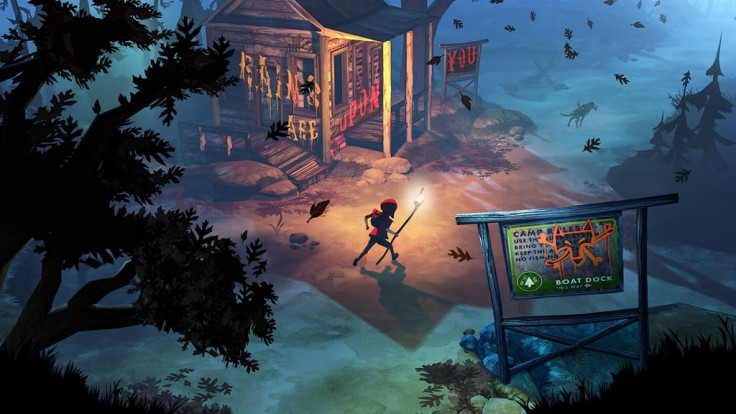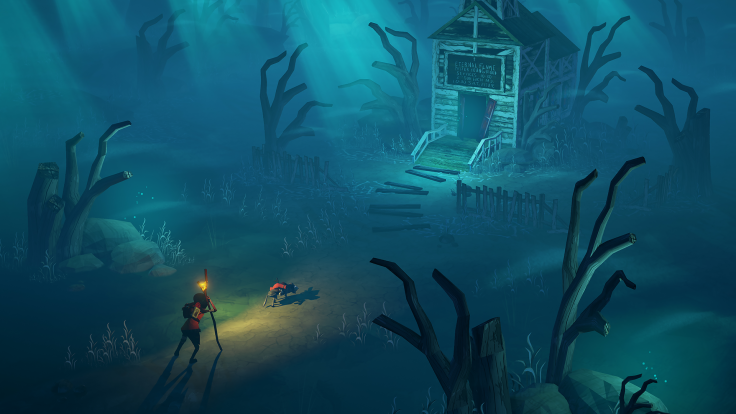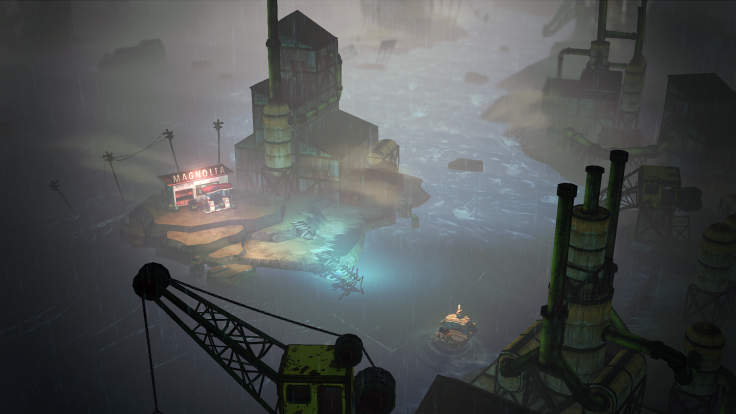Poor Scout! This must be what I thought most often as I navigated the brave new world of The Flame in the Flood. My plucky and resourceful main character, rendered in blocky, gothic art, and Aesop, her brave and seemingly immortal pup, went through hell for hours under my inept command. If she wasn’t drowning in the middle of the river right next to a church in the wild, a hog-infested campsite or a pointy outcropping still glowing with loot, she was dying of a staph infection, a snakebite or hunger.
But mostly, Scout was drowning in the rushing river that forms the veins of this game’s brutal world. The amount of times I drowned in Flame in The Flood is roughly equivalent to the amount of times I starved to death in Don’t Starve. If another roguelike (or roguelite) procedural survival game comes out called Don’t Die Of A Thousand Paper Cuts Only To Be Gored By A Unicorn , I fully expect to die over and over again only to be gored by a unicorn.
Over and over again.

Both land and river in The Flame in the Flood were a big challenge for me the entire time I played. Life on land is filled with perils: snakes, wolves, hogs and bears are all powerful and dangerous, capable of inflicting poisoned bites, broken bones and lacerations that will rapidly fester. (The wound progression is super neat, until you die from it.) The only option for young Scout is to flee in the face of such overwhelming odds, at least at first, until you get the courage up to brandish your torch against the dark.
How do you cope with the things that go bump in the night? You’re supposed to set the hostile wildlife against each other, or craft traps with small bait you captured by setting another trap in the first place, or make weapons and valiantly take the suckers down. Me? I ran away each time, howling back to the safety of the docks where the wolves couldn’t follow.

Life on water is no less dangerous, especially before you’ve upgraded your raft, which can only take a certain number of blows before calling it quits. You will smash against debris in the middle of the river, between rocks as you try to get out of a location, in rapids, in calm waters, before a turn, right before that marina you needed, etc. I played on PC where maneuvering the raft was tricky at best and screamingly frustrating at worst. Adding things like a rudder and a motor to your raft make the travel easier.
But when I played Oregon Trail as a kid, I never took the Bartow Toll Road because rafting down the Columbia River before hitting the Willamette Valley was way more fun. And rafting down the river is a lot of fun in The Flame in the Flood , too. You can loot random rock outcrops as they go by, and locations are marked with an icon indicating their type (which tells you what you’re likely to find there), direction, and distance from you. Can you be freewheeling and white-knuckled at the same time? When the big river lights up like a molten sheet in the sunlight, rapids churning straight ahead, you can.

For the first four hours, the only music I seemed to hear was a short, solemn series of notes twanged alone on a steel guitar, interspersed with silence. Then the music started changing. There was briskness and energy to it, that down-home liveliness that the guitar strummin’ of the American South is so famous for. It matched the feeling I got when I turned a corner only to see the whole river grow bright with sunshine. Unobtrusive, sometimes haunting, sometimes exultant, I really liked the music -- once I started hearing more than the same four notes, that is. (Still not sure what happened there.)
As for the story, it had enough shades of Everybody’s Gone to the Rapture to make me ravenous for more . Randomly-encountered characters like a pair of feral children and a wistful gravekeeper shed just a little light on your cold, wet world. Boats in the air came and took away the Steady? Tell me more, kiddos. The art for all the characters is absolutely incredible, done in the best style of spooky children’s books. One of the feral children even had a little crown on their head, very Where the Wild Things Are . A witch’s beady eyes stare over her green cauldron as her illustration seems to shimmer. I’d snatch up the art book for The Flame in the Flood in a heartbeat.

As far as clunky points, maneuvering between the different menus is kind of a pain. I found myself lost in clicks more than once, trying to figure out what to keep in my inventory: what do I need to complete my goals? How about to cure my afflictions? How many do I have of that item right now? Do I have to combine stacks between myself and the raft storage? Does the dog have any? Did I insulate these gloves yet? Do I really need 6 jars? The amount of stuff to craft isn’t overwhelming, but the amount of clicks needed to get to all the information is pretty tedious.
Part of the game’s challenge is managing your inventory, but you also have to manage Scout’s needs for hunger, thirst, rest, and warmth, so it’s additionally cruel (if realistic) that time passes as you’re perusing your crafting recipes. You actually lose hunger and thirst as you stand there clicking around.
Additionally, the hotkeys were counterintuitive and not too useful for me: I’d click 3 for my torch, then select my torch with the mouse, then have to hit Escape to get out of the hotkeys and be able to move again, not 3. In this time, a wolf could eat me alive. And it usually did. This was a big obstacle to mastering the art of hunting.
That being said, the fact that The Flame in the Flood lets you start from checkpoints in Campaign Mode is really helpful and vastly appreciated. Normally these types of games don’t let you save at all, so this lifeline is huge. There’s also an Endless Mode if you don’t care about the story. Frankly, I’m not too sure what the difference really means between the two. There’s no Willamette Valley to reach here: you’re just going where the river takes you.
If you’ve already mastered Don’t Starve , you’ll be quite at home in the Flood. But once you master the skills of this game like hunting, crafting and choosing how to manage your inventory, there’s not much left for you to do unless developer Molasses Flood decides to throw some DLC on the pot. Of course, you can always chase down the rare denizens of your sodden post-apocalypse to learn why the world’s gone to hell in a very damp basket.

The Flame in the Flood is the first game out of The Molasses Flood, a new development studio headed by former Bioshock art director Scott Sinclair. The Flame in the Flood is available on Steam for PC, Mac, and Xbox One for $19.99. A review copy was provided by the publisher.


















